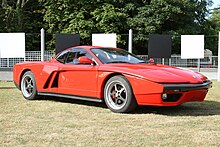Ercole Spada
Ercole Spada (born July 26, 1937 in Busto Arsizio ) is an Italian automobile designer who has designed numerous Italian and German vehicles since 1960. In the 1960s Spada was chief designer at Zagato , later he designed bodies for mass-produced vehicles for BMW and Fiat . He currently works for the design studio Spadaconcept. Ercole Spada's creations are often viewed as timelessly elegant. Regardless of his productivity and his influence on other vehicle designers, Spada is still one of the most unknown designers in Europe.
Professional biography
From 1956 to 1960 Spada trained as a designer at the Istituto Technico Industriale Feltrinelli in Milan. In 1960 he took up a job for Zagato that would last until 1969. After just a few months, Spada became the chief designer of the traditional Milanese bodywork manufacturer. During this time Spada designed numerous sports cars for Zagato that are now considered classics. Spada is widely regarded as Zagato's most important designer, responsible for the company's most creative and successful times. They include the Alfa Romeo Junior Zagato , the Alfa Romeo 2600 SZ and the Lancia Fulvia Sport . In addition, Spada designed one-offs or mini series vehicles for Aston Martin and Bristol .
In 1969 Spada left Zagato to become chief designer of the Ford concern Carrozzeria Ghia . Here he designed, among other things, the Ford GT70 , a sports car only produced in Great Britain in small numbers.
From 1976 to 1983 Spada worked at BMW in Germany. Together with the chief designer Claus Luthe , who was newly appointed in 1976 , he designed two series of the 5 and 7 series, which were sold into the 1990s.
In 1983 Spada returned to Italy. He became head of design at the I.DE.A Institute in Turin , which designed numerous mass-produced vehicles for the Fiat group in the 1980s. Spada's designs here primarily referred to the newly developed platform of the Fiat Tipo , numerous offshoots of which were also developed for the Alfa Romeo and Lancia brands. Spada's last creation for the Fiat group was the Alfa Romeo 166 .
In 1992, Spada began working for Zagato again. During this time, a number of individual pieces or small series vehicles were created for Ferrari and Aston Martin.
In 2006, Spada founded the Turin-based company Spadaconcept with his son Paolo and Domiziano Boschi, which specializes in automotive and industrial design. Ercole Spada is currently the company's President.
Cars designed by Spada
Zagato
- Alfa Romeo Giulietta Sprint Zagato (1960)
- Alfa Romeo 2600 SZ (1962)
- Alfa Romeo Giulia TZ (1962)
- Alfa Romeo Junior Zagato (1969)
- Aston Martin DB4 GT Zagato (1960)
- Bristol 407 GTZ Zagato (1961)
- Lancia Flavia Sport (1962)
- Flaminia Supersport (1963)
- Lancia Fulvia Sport (1965)
- Lancia Flavia Zagato (1967)
- Rover 2000 TCZ (1967)
- Volvo GTZ 2000 (1969)
- Ferrari FZ93 (1992, based on Ferrari Testarossa )
BMW
- BMW E32 (second series of the 7 series, 1986–1994)
- BMW E34 (third series of the 5 series, 1987–1996)
I.DE.A
- Alfa Romeo 155 (1992-1998)
- Fiat Tipo (1988)
- Fiat Tempra (1990)
- Lancia Dedra (1989)
- Lancia Delta Nuova (1993-1999)
- Nissan Terrano II (1993-2004)
Spadaconcept
- Spada TS Codatronca (2007)
Web links
Individual evidence
- ↑ Bart Lenaerts, Lies de Mol: Spada. The long story of a short tail. Told by a father and a son. Waft Publishing, Antwerp 2014, p. 8
- ^ "Cars which until today feel modern". See short biography of Ercole Spadas on the website www.bmwism.com ( memento of the original from November 22, 2012 on WebCite ) Info: The archive link was automatically inserted and not yet checked. Please check the original and archive link according to the instructions and then remove this notice. (accessed on August 20, 2011).
- ↑ Spada's biography on the website www.zagato-cars.com (accessed on August 20, 2011).
| personal data | |
|---|---|
| SURNAME | Spada, Ercole |
| BRIEF DESCRIPTION | Italian vehicle designer |
| DATE OF BIRTH | July 26, 1937 |
| PLACE OF BIRTH | Busto Arsizio |








